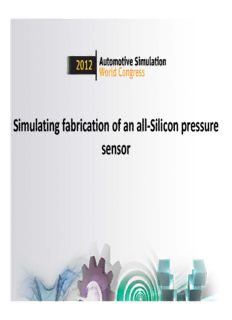
Simulating fabrication of an all-Silicon pressure sensor PDF
Preview Simulating fabrication of an all-Silicon pressure sensor
Simulating fabrication of an all‐Silicon pressure sensor Overview • All‐silicon pressure sensor – Why silicon? – Operating principle • The fabrication process – Step‐by‐step description • The simulation challenge – Duplication of the fabrication process – Meshing, loads and boundary conditions • Results Silicon in the electronics industry • Why silicon? – Abundance – Precise, well understood processing methods well suited for miniaturization – Processing is based on photographic techniques well suited for miniaturization – Batch fabrication producing hundreds of identical devices on one single wafer • Uses driven by silicon’s mechanical properties – Sensor & transducers • Micromechanical and nano‐scale devices created using chemical etching and thin film deposits – Easy integration of devices with integrated circuits All‐Silicon pressure transducers • Operating principle – The diaphragm is made of a thin layer of silicon – A Wheatstone bridge circuit is created on top of the diaphragm – Deflection of the diaphragm due to applied pressure is detected as a resistance change which is easily correlated to the applied pressure – This type of sensor can be made to measure gauge or absolute pressure All‐Silicon pressure transducer The Fabrication Process • The fabrication process is modeled as follows: – Step 1: The Si substrate, a 1 u thick layer of Sio2, and a 768u Si layer is cooled from 1050C (stress free temperature) to room temperature – Step 2: Excess silicon is removed using a grinding process to produce a 15u‐thick diaphragm – Step 3: Diaphragm is formed by etching a cavity in the substrate at room temperature – Step 4: Increase the assembly temperature to 450C – Step 5: Attach the glass pedestal – Step 6: Cool down to room temperature Fabrication process The structure Si <100> Si Wafer Si <100> Si Wafer Si <100> Si Oxide Si <100> Si Substrate Glass Pedestal The simulation challenge • ! Commands inserted into this file will be executed just Temp. °C prior to the Ansys SOLVE command. • ! These commands may supersede command settings set 1200 by Workbench. • ! Active UNIT system in Workbench when this object was created: Metric (mm, kg, N, s, mV, mA) 1000 • nropt,AUTO • msave,OFF 800 • allsel • Ekill, ALL • Ealive, NS_Excess_Si 600 • Ealive, NS_SubstrateCavity • Ealive, NS_Substrate • Ealive, NS_UpperOxidePerimeter 400 • Ealive, NS_UpperOxideCtr • Ealive, NS_DiaphragmCtr 200 • Ealive, NS_DiaphragmPerimeter • Ealive, NS_LowerOxidePerimeter • Ealive, NS_LowerOxideCtr 0 0 2 4 6 8 Load Step The simulation challenge • Goals of the analysis – Simulate the fabrication process to determine if significant residual stresses exist in the final structure • Pressure sensor model – Create a model that can be subjected to additional manufacturing and/or operating loads – Determine if the existence of a 1 µ oxide layer contributes to the failure of the diaphragm
Description: